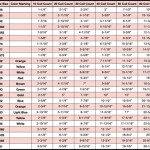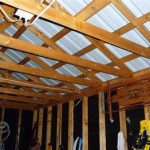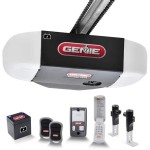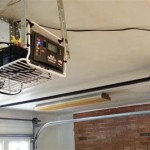Screen For Bottom Of Garage Door: An In-Depth Guide
Gaps beneath garage doors are a common problem for homeowners. These openings allow pests, debris, drafts, and water to enter the garage, leading to a range of potential issues. While bottom seals are designed to create a tight barrier, they can wear down over time or may not be sufficient to address irregularities in the garage floor surface. A screen for the bottom of the garage door presents an alternative or supplemental solution to address this persistent problem.
This article aims to provide a comprehensive understanding of the benefits, types, installation methods, and maintenance considerations associated with using a screen designed to close the gap at the bottom of a garage door. Understanding these factors is crucial for homeowners seeking a practical and effective way to maintain a clean, secure, and energy-efficient garage environment.
Benefits of Using a Screen for the Bottom of a Garage Door
Employing a screen for the bottom of a garage door offers several significant advantages, making it a valuable addition for many homeowners. These benefits extend beyond simple aesthetics, impacting the garage's functionality, cleanliness, and overall protection against external elements.
One primary benefit is pest control. Gaps under garage doors are ideal entry points for rodents, insects, and other unwanted critters. These pests can damage stored items, contaminate the space, and even pose health risks. A screen, particularly one with a fine mesh, effectively blocks these pests from entering, creating a more sanitary and comfortable environment. The physical barrier the screen presents is often more reliable than chemical pest control methods, offering a long-term solution.
Furthermore, a screen helps prevent the entry of debris. Leaves, dust, dirt, and other outdoor materials can accumulate inside the garage, leading to a messy and potentially hazardous environment. By filling the gap, the screen keeps these materials out, reducing the need for frequent cleaning and maintaining a more organized workspace. This is particularly important for homeowners who use their garage for hobbies, storage, or as a workshop.
Energy efficiency is another key advantage. Gaps under garage doors contribute to heat loss during the winter and air conditioning escape during the summer. By closing this gap, the screen helps to insulate the garage. This reduces the strain on heating and cooling systems, leading to lower energy bills and a more comfortable garage temperature. This improved energy efficiency can be a significant long-term cost saving, particularly in regions with extreme weather conditions.
Finally, a screen can provide a barrier against water intrusion. During heavy rain or snow, water can seep under the garage door and potentially cause damage to stored items or the garage floor itself. A screen, especially when combined with a well-sealed bottom seal, can significantly reduce the amount of water entering the garage, preventing water damage and the growth of mold or mildew. This is particularly important in areas prone to flooding or heavy precipitation.
Types of Screens Suitable for Garage Door Bottoms
The market offers various types of screens designed specifically or adapted for use at the bottom of garage doors. Each type has its own characteristics, advantages, and disadvantages, making it essential to consider the specific needs and priorities of the homeowner when selecting an appropriate screen.
One common type is a flexible mesh screen. These screens are typically made of fiberglass, aluminum, or polyester mesh and are designed to be attached to the garage door and the floor using Velcro, magnets, or other fastening systems. They are relatively easy to install and remove, making them a convenient option for seasonal use or for homeowners who need occasional access to the space outside the garage door. However, they may not be as durable as other options and may require more frequent replacement.
Another type is a brush seal. Brush seals consist of dense bristles that create a flexible barrier against pests, debris, and drafts. They are typically mounted to an aluminum or plastic carrier, which is then attached to the bottom of the garage door. Brush seals are highly effective at conforming to uneven surfaces, making them a good choice for garages with slightly irregular floors. They are also relatively durable and can withstand repeated opening and closing of the garage door. The effectiveness of the brush seal depends heavily on the density and quality of the bristles used.
A third option is a vinyl weather stripping with an integrated screen. This combines a traditional vinyl weather seal with a woven screen material. This option provides both a weather-tight seal and a barrier against insects, making it a comprehensive solution. The vinyl weather stripping is typically attached to the bottom of the garage door with nails, screws, or adhesive. The screen is integrated into the vinyl, providing continuous protection. This type of screen tends to be more durable than flexible mesh screens, but may be slightly more difficult to install.
Additionally, some homeowners opt for DIY solutions using materials like hardware cloth or expanded metal. These materials can be cut to size and attached to a frame or directly to the garage door. While this can be a cost-effective option, it requires more effort and skill to install properly and may not provide the same level of performance as commercially available screens. The suitability of DIY solutions depends on the homeowner's skills and the specific needs of the garage.
Choosing the right type of screen depends on factors such as budget, desired level of protection, ease of installation, and durability requirements. It is important to carefully consider these factors before making a purchase to ensure that the chosen screen meets the specific needs of the garage.
Installation and Maintenance of Garage Door Bottom Screens
Proper installation and regular maintenance are crucial for ensuring the effectiveness and longevity of a garage door bottom screen. Incorrect installation can compromise the screen's ability to block pests and debris, while neglecting maintenance can lead to premature wear and tear, reducing its lifespan.
The installation process varies depending on the type of screen chosen. Flexible mesh screens with Velcro or magnetic attachments are generally the easiest to install, requiring minimal tools or expertise. The surface of the garage door and floor should be cleaned thoroughly before attaching the Velcro or magnetic strips to ensure a strong bond. Precise alignment is important to create a complete seal. It is crucial to follow the manufacturer's instructions carefully to ensure proper installation.
Brush seals and vinyl weather stripping with integrated screens typically require more effort to install. These types of screens are often attached with screws or nails, necessitating the use of a drill or screwdriver. Proper alignment is essential to ensure a tight seal and smooth operation of the garage door. In some cases, it may be necessary to adjust the position of the garage door track or rollers to accommodate the added thickness of the screen. Professional installation is recommended for homeowners who are not comfortable with basic carpentry or mechanical tasks.
Maintenance of garage door bottom screens primarily involves regular cleaning and inspection. Debris such as leaves, dirt, and cobwebs can accumulate on the screen, reducing its effectiveness and potentially causing damage. The screen should be cleaned regularly with a brush or vacuum cleaner to remove any accumulated debris. It is also important to inspect the screen for any signs of damage, such as tears, holes, or loose attachments. Damaged screens should be repaired or replaced promptly to maintain their effectiveness.
For screens with Velcro or magnetic attachments, it is important to periodically check the strength of the bond and reattach the strips as needed. Brush seals should be inspected for worn or damaged bristles and replaced if necessary. Vinyl weather stripping should be inspected for cracks or tears and replaced to maintain a weather-tight seal. Lubricating the garage door hinges and rollers can also help to ensure smooth operation and prevent the screen from being damaged during opening and closing.
Proper installation and consistent maintenance are essential for maximizing the benefits and extending the lifespan of a garage door bottom screen. By following these guidelines, homeowners can ensure that their garage remains protected from pests, debris, and the elements, contributing to a cleaner, more comfortable, and more energy-efficient environment.

Garage Door Screen 16x7 Ft Magnetic Closure Heavy Duty Weighted Bottom S Ebay

Grusce Garage Door Screen Magnetic Closure Mesh Pet Retractable Curtain Cover With Weighted Bottom 16x7ft For 2

Grusce Garage Door Screen Magnetic Closure Mesh Pet Retractable Curtain Cover With Weighted Bottom 16x7ft For 2

Garage Door Screen Single Magnetic Closure Weighted Bottom Insects Bugs Mesh New 785577184925 Ebay

Yescom 16x7 Ft Garage Door Screen Single Car Insect Bug Mesh Magnetic Weighted Bottom

Garage Door Screen 16 X 7 Ft For 2 Cars 5 Lbs Heavy Duty Fiberglass Mesh Quick Entry With Self Sealing Magnet And Weighted Bottom Kids Pets

Garage Door Screen Net 16x7 Ft For 2 Car Magnet Closure Bottom Heavy Duty Ebay

Garage Door Screen 2 Car Magnetic Closure Reinforced Temu

Vevor 18 3 X 7 15 Ft Garage Door Screen For Winter Insulation Kit

Siubich Garage Screen Door For 2 Car 13 12x6 65ft Magnetic With Retractable Fiberglass Mesh And Heavy Duty Weighted Bottom Easy








